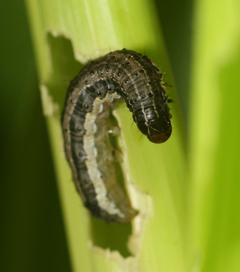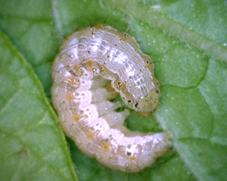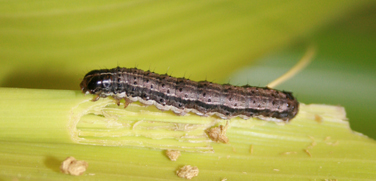| Mechanisms of resistance to Cry and Vip proteins | |||
Funded by This research is currently supported by Agriculture and Food research Initiative (AFRI) competitive grants No. 2018-67013-27820 and 2021-67013-33567 from the USDA National Institute of Food and Agriculture |
|||
Can we use targeted DNA sequencing to monitor for resistance to Bt plant incorporated protectants?How frequent are these resistance alleles?Since their commercialization in 1996, transgenic crops producing insecticidal proteins from the bacterium Bacillus thuringiensis (Bt crops) have revolutionized agricultural pest control. Benefits of these Bt plant incorporated protectants (PIPs) include high efficacy and lack of toxicity to non-target organisms. The most important threat to the susbtainability of Bt PIPs is the evolution of resistance by target pests. After >25 years since their commercialization, there are reports of resistance to Bt PIPs developing in lepidopteran and coleopteran pests. One of the key elements of resistance management mandates for Bt PIPs is monitoring for resistance in target insects populations, which is commonly done using bioassays with larvae from F2 crosses. Our efforts are focused on developing targeted DNA sequencing as a mores sensitive and cost-effective alternative for Bt resistance monitoring. Our model for this research is resistance to Bt corn producing the Cry1F PIP in populations of the the fall armyworm (Spodoptera frugiperda). This insect is particularly interesting because it has evolved field-evolved practical resistance to the Cry1F PIP at different locations in the native range of S. frugiperda (Puerto Rico, Florida, North Carolina, Brazil, Argentina). Moreover, S. frugiperda is quickly becoming a global super pest threatening global food production. Our work takes advantage of fall armyworm strains originated in Puerto Rico with field-evolved practical resistance to corn producing Cry1F, as well as our previous work identifying resistance mechanisms to Bt PIPs and alleles responsible. Our current goals include the use of targeted DNA sequencing to determine the frequency of known resistance alleles to the Cry1F PIP and identify novel candidate resistance alleles and their frequency in S. frugiperda populations from the USA, Puerto Rico, Brazil, and Argentina. In addition, we are using the the same DNA-based tools to asses the risk of resistance to Bt PIPs in the invasive range of S. frugiperda.  |
|||
| Cry1F-resistant Spodoptera frugiperda larva feeding on Bt corn | |||
| What is the mechanism of resistance to Vip3Aa PIPs? | |||
The Vip3Aa protein from Bt is an important PIP in corn and cotton due to its high activity against key pests. While practical resistance to this PIP has yet to be documented, there are examples of field-collected insects harboring major Vip3Aa resistance genes. In contrast to extensive knowledge of the mode of action and resistance mechanisms to Cry PIPs, information in these areas for Vip3Aa is scarce. Our current collaborative project with Drs. David Kerns and Fey Yang (Texas A&M), Fangneg Huang (Louisiana State University), and Meg Staton (Univerisyt of Tennessee) aims at adressing this current knowledge gap by identifying the mechanism and genes responsible for resistance to Vip3Aa PIPs.
Our model for this research are strains of corn earworm (Helicoverpa zea) and fall armyworm (Spodoptera frugiperda) displaying >500-fold resistance to Vip3Aa. is resistance to Bt corn producing the Cry1F PIP in populations of the the fall armyworm (Spodoptera frugiperda). Both insects are key pests of corn and cotton that have evolved practical resistance to Cry1 PIPs in the US. Detection of major Vip3Aa resistance alleles in F2 screens for both species confirms the potential for evolving resistance to Vip3Aa exists. Moreover, S. frugiperda is quickly becoming a global super pest threatening global food production. Our current work takes advantage of available Vip3Aa-resistant strains of H. zea and S. frugiperda and proteomic and genomic resources to identify the mechanism behind Vip3Aa resistance. Our project includes the use of targeted DNA sequencing to estimate the frequency of Vip3Aa-resistance alleles in field populations of corn earworm and fall armyworm. |
|||
 |
 |
||
Larvae of corn earworm (Helicoverpa zea, left) and fall armyworm (Spodoptera frugiperda) |
|||
Publications from these projects |
|||
| Schlum, K.A., Lamour, K., de Bortoli, C.P., Banerjee, R., Meagher, R., Pereira, E., Murua, M.G., Sword, G.A., Tessnow, A.E., Viteri Dillon, D., Linares Ramirez, A.M., Akutse, K.S., Schmidt-Jeffris, R., Huang, F., Reisig, D., Emrich, S.J., Jurat-Fuentes, J.L. (2021) "Whole genome comparisons reveal panmixia among fall armyworm (Spodoptera frugiperda) from diverse locations" BMC Genom. 22(1):179. PDF | |||
| Jurat-Fuentes, J.L., Heckel, D.G., and Ferre, J. (2021) "Mechanisms of resistance to insecticidal proteins from Bacillus thuringiensis" Ann. Rev. Entomol., 66:6.1-6.22. PDF | |||
| Abdelgaffar, H., Perera, O.P., and Jurat-Fuentes, J.L. (2020) "ABC transporter mutations in Cry1F-resistant fall armyworm (Spodoptera frugiperda) do not result in altered susceptibility to selected small molecule pesticides" Pest. Manag. Sci. PDF | |||
| Gimenez, S., H. Abdelgaffar, G. Le Goff, F. Hilliou, C. A. Blanco, S. Hanniger, A. Bretaudeau, F. Legeai, N. Negre, J. L. Jurat-Fuentes, E. Alencon, and K. Nam (2020) "Adaptation by copy number variation increases insecticide resistance in the fall armyworm" Comm. Biol. 3(1):664. PDF | |||
| Pinos, D., Chakroun, M., Millán-Leiva, A., Jurat-Fuentes, J.L., Wright, D.J., Hernández-Martínez, P., and Ferré, J. (2020) "Reduced membrane-bound alkaline phosphatase does not affect binding of Vip3A in a Heliothis virescens resistant colony" Toxins 12(6): E409. PDF | |||
| Gomis-Cebolla, J., Ferreira Dos Santos, R., Wang, Y., Caballero, J., Caballero, P., He, K., Jurat-Fuentes, J. L., and J. Ferré (2020) "Domain shuffling between Vip3Aa and Vip3Ca: Chimera stability and insecticidal activity against European, American, African, and Asian Pests" Toxins 12(2): E99. PDF | |||
| Yang, F., González, J. C., Little, N., Reisig, D., Payne, G., Dos Santos, R., Jurat-Fuentes, J. L., Kurtz, R., and D. Kerns (2020) "First documentation of major Vip3Aa resistance alleles in field populations of Helicoverpa zea (Boddie) (Lepidoptera: Noctuidae) in Texas, USA" Sci. Rep. 10(1): 5867. PDF | |||
Banerjee, R., J. Hasler, R. Meagher, R. Nagoshi, L. Hietala, F. Huang, K. Narva, and J. L. Jurat-Fuentes (2017) "Mechanism and DNA-based detection of field-evolved resistance to transgenic Bt corn in fall armyworm (Spodoptera frugiperda)" Sci. Reports 7(1): 10877. PDF |
|||
Nagoshi, R. N., D. Koffi, K. Agboka, K. A. Tounou, R. Banerjee, J. L. Jurat-Fuentes, and R. L. Meagher (2017) "Comparative molecular analyses of invasive fall armyworm in Togo reveal strong similarities to populations from the eastern United States and the Greater Antilles" PloS ONE, 12(7): e0181982. PDF |
|||
Jakka, S. R. K., Gong, L., Hasler, J., Banerjee, R., Sheets, J. J., Narva, K., Blanco, C. A., and J. L. Jurat-Fuentes (2015) "Field-evolved Mode 1 fall armyworm resistance to Bt corn associated with reduced Cry1Fa toxin binding and midgut alkaline phosphatase expression" Appl. Environ. Microbiol. 82(4): 1023-1034. PDF |
|||
Jakka, S. R. K., Knight, V. R., and J. L. Jurat-Fuentes (2014) "Spodoptera frugiperda (J.E. Smith) with field-evolved resistance to Bt maize are susceptible to Bt pesticides” J. Inverbr. Pathol. 122: 52-54. PDF |
|||
Jakka, S. R. K., Knight, V. R., and J. L. Jurat-Fuentes (2014) "Fitness costs associated with field-evolved resistance to Bt maize in Spodoptera frugiperda (Lepidoptera: Noctuidae)” J. Econ. Entomol. 107(1): 342-351. PDF |
|||
Jurat-Fuentes, J. L., Karumbaiah, L., Jakka, S. R. K., Ning, C., Liu, C., Wu, K., Jackson, J., Gould, F., Blanco, C., Portilla, M., Perera, O. P., and M. J. Adang (2011) “Reduced levels of membrane-bound alkaline phosphatase are common to lepidopteran strains resistant to Cry toxins from Bacillus thuringiensis” PLOS One 6(3): e17606. PDF |
|||
Blanco, C., Portilla, M., Jurat-Fuentes, J. L., Sanchez, J. F., Viteri, D., Vega-Aquino,P., Teran-Vargas, A. P., Azuara-Dominguez, A., Lopez, J. D., Arias, R., Zhu, Y.-C., Lugo –Barrera, D., and R. Jackson (2010) “Susceptibility of isofamilies of Spodoptera frugiperda (Lepidoptera: Noctuidae) to Cry1Ac and Cry1Fa proteins of Bacillus thuringiensis” Southwest. Entomol. 35: 409-415. PDF |
|||
Dr. Juan Luis Jurat-Fuentes
Department of Entomology and Plant Pathology The University of Tennessee 370 Plant Biotechnology Building 2505 E. J. Chapman Drive Knoxville, TN, 37996 Tel: (865) 974-5931 jurat@utk.edu |
|||

